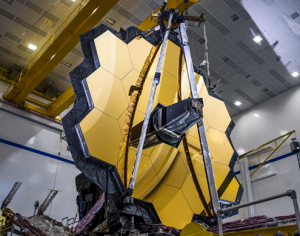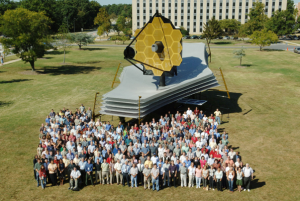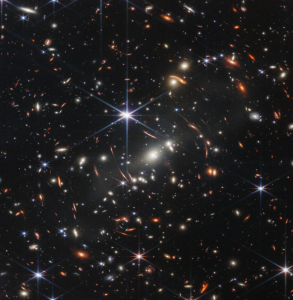James Webb Telescope

Source: NASA
ABOUT
The James Webb Space Telescope (referred to as JWST or Webb) is an orbiting infrared observatory. The telescope will expand on Hubble Space Telescope discoveries with improved features for sensitivity and longer wavelength coverage. The telescope can see planetary systems and stars forming today by looking inside dust clouds. Longer wavelength coverage allows the telescope to look closer at the beginning of time.[1] Webb will also study all phases of the history of the Universe. This includes the evolution of the solar system, first luminous glows after the Big Bang, and solar systems of life supporting planets like Earth.[2]
Webb is a shared mission between NASA, the Canadian Space Agency (CSA), and the European Space Agency (ESA), making it an international collaboration.[3]
LAUNCH
Webb was launched on December 25, 2021, on an Ariane 5 rocket from Arianespace’s ELA-3 launch complex at Europe’s Spaceport (near Kourou, French Guiana). The launch site and vehicle were contributed by the European Space Agency.[4]
The telescope has folding capabilities to fit inside the rocket. The three primary components of the Launch Segment are the Launch Vehicle, Payload Adapter, and launch campaign preparation and launch campaign.[5]
- Launch Vehicle – the Ariane 5 features a cryogenic upper stage, single launch configuration, and a long payload that allows for a maximum 4.57-meter static diameter with a 16.19-meter usable length[6]
- Payload Adapter – the payload adapter is made up of the Cone 3936 and ACU 2624 lower cylinder and clamp-band. This is responsible for separating mechanical and electrical interface between the Launch Vehicle and Webb Observatory[7]
- Launch campaign preparation and launch campaign – the Launch campaign preparation and launch campaign were the shared responsibility of NASA, ArianeSpace, ESA, and Northrop Grumman[8]
MISSION GOALS:
- “Search for the first galaxies or luminous objects formed after the Big Bang
- Determine how galaxies evolved from their formation until now
- Observe the formation of stars from the first stages to the formation of planetary systems
- Measure the physical and chemical properties of planetary systems, including our own Solar System, and investigate the potential for life in those systems”[9]
INSTRUMENTS:
Instruments used for this mission include Near Infrared Camera (NIRCam), Near Infrared Spectrograph (NIRSpec), Mid Infrared Instrument (MIRI), and Fine Guidance Sensors/Near Infrared Imager and Slitless Spectrograph (FGS/NIRISS).[10]
Near Infrared Camera (NIRCam) – NIRCam is the primary imager for Webb. The infrared wavelength from range 0.6 to 5 microns is covered by NIRCam. Light is detected from young stars in the Milky Way and Kuiper Belt objects, earliest stars and galaxies in the midst of formation, and population of stars in nearby galaxies. The coronagraph instruments included in the NIRCam will allow photo capture of faint objects around a central bright object.[11]
Near Infrared Spectrograph (NIRSpec) – NIRSpec is a spectrograph or spectrometer that can disperse light into a spectrum, from an object. The NIRSpec has the capability of studying 100 objects at a time and is the first with this capability in space. This capability was necessary for Webb to study thousands of galaxies on its mission, since it can take hundreds of hours to collect the amount of light needed to put together a spectrum.[12]
Mid Infrared Instrument (MIRI) – MIRI (containing a camera and spectrograph) can see light within the mid-infrared region of the electromagnetic spectrum. This instrument covers the 5 to 28 micron wavelength range. MIRI sees newly forming stars, redshifted light of distant galaxies, objects in the Kuiper belt, and faintly visible comets due to its sensitive detectors. The camera portion of this instrument will deliver wide-field broadband imaging and the spectrograph will deliver new physical details of distant objects with medium-resolution spectroscopy.[13]
Fine Guidance Sensors/Near Infrared Imager and Slitless Spectrograph (FGS/NIRISS) - This sensor ensures high-quality images by allowing Webb to point precisely. Science objectives for the FGS/NIRISS include exoplanet transit spectroscopy, first light detection, and exoplanet detection and characterization. The wavelength range for FGS/NIRISS is 0.8-5.0 microns. The instrument includes three main modes that focus on a different wavelength range. FGS points the telescope as a “guider.”[14]
BUDGET
The fiscal year (FY) 2023 budget request for the James Webb Space Telescope can be found below, along with requests from previous years and projections into the future.[15]

Source: NASA
The FY 2023 budget request for Webb is split between the James Webb Space Telescope and Webb Science, which includes money for community science grants. Costs due to COVID-19 impacts, a launch delay, and technical delays resulted in support for an increase of $115 million for estimated development costs for FY 2023. In order to support an increase in science for the operations phase, the budget backs a $90 million augmentation to Webb Science from FY 2022-2027.[16]
TEAM
This project includes more than 1200 engineers, scientists, and technicians from over 27 states and 14 countries. NASA Goddard Space Flight Center was the location for testing and assembly of the instruments and mirror for Webb.[17]
PROJECT MANAGERS FOR THE JAMES WEBB TELESCOPE OPERATIONS PROJECT:
Project Manager: Alan Johns
Deputy Project Manager: Bonnie Seaton
Deputy Project Manager/Resources: Robyn O’Mara
Mission Systems Engineer: Mike Menzel [18]

Source: NASA
NASA Centers involved with Webb include Goddard Space Flight Center (Webb project and ISIM [Integrated Science Instrument Module] component management), Jet Propulsion Laboratory (Mid-Infrared Instrument management), Ames Research Center (development of Detector Technology), Johnson Space Center (Observatory Test Facilities), Marshall Space Flight Center (development of Mirror Technology and Environmental Research), and Glenn Research Center (development of Cryogenic Component).[20]
Academic and industry partners are the University of Arizona, Ball Aerospace, L3Harris Technologies, Lockheed Martin, Northrop Grumman, and the Space Telescope Science Institute.[21]
RECENT UPDATES
In March 2022, NASA reported that starlight was successfully captured through Webb’s 18 mirror segments. Those dots of light were refined and stacked, creating an initial alignment of a single star. After this, scientists used “fine phasing” and “coarse phasing” to get the 18 primary mirror segments to act as one by making small adjustments to the position of these segments. This can create a focused image of a single star.[21] The team then began working on the rest of the alignment steps before preparations for the final science instrument. NIRSpec, MIRI, and FGS/NIRISS will be included in the telescope alignment process, where instrument evaluation was performed by an algorithm. Calculations for adjustments were made after the algorithm completed its evaluation. From here, the last alignment step was completed to fix any minor mirror segment positioning errors.[22]
NASA reported that Webb attained its final operating temperature in April (7 kelvins or 266 degrees Celsius/minus 447 degrees Fahrenheit). Webb’s four instruments need to reach this temperature to detect infrared light emitted from warm objects outside of themselves. This temperature also necessarily minimizes dark current, which provides false impressions of external light sources. This leaves scientists open to discover true impressions of light sources. MIRI needs to get colder than the other instruments, as it’s more perceptible to dark current. This was tested with instrument checks from scientists to confirm functionality in the frigid temperature.[23]
In May, reports from NASA indicated scientists were going to test and prepare the science instruments (a process called instrument commissioning) before the spectra debut and first images would be released in the summer.[24]
Webb’s first full-color image was released in July 2022 and the first full set of images is available here.[25]

Source: NASA
In August 2022, NASA announced sound capabilities for some of their full-color infrared images and data captured by Webb. These are mapped sounds using Webb’s data, not sounds from space. These sonifications are meant to support vision impaired and blind listeners, as well as add to anyone’s experience of viewing Webb’s visual images.[27]
The James Webb Space Telescope homepage can be accessed here.
Photos related to Webb’s development, launch, project design, and commissioning and outreach activities are archived here, via NASA’S Flickr site.
Other images, including those captured by Webb, can be accessed by visiting NASA’s Flickr site here.
Updated November 2022, by Jackie Johnson

Comments are closed.